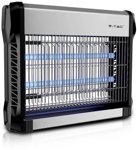Electric Fly Killers
Attract and zap flies using a high voltage killing grid.
Glueboard Fly Killers
Discreet and hygienic fly killing.
T5 Fly Killer Tubes
T8 Fly Killer Tubes
T12 Fly Killer Tubes
Fly Killer Lamps
Electric Fly Killer / Glue Board Units
Introducing a wide and varied collection of Fly Killers, a reliable and functional light fitting that attracts and kills flies. Browse our white and stainless steel Insect-o-cutors developed to reduce insects in many environments including, warehouses and kitchens. Each fly zapper unit has a removable tray; designed for cleaning and discarding dead flies. Fly killers have a wide array of applications such as restaurants, bars, abattoirs, and breweries and can be used even in the home. Glue board fly killers are best suited to food preparation and handling areas and other sensitive environments due to their silent operation and hygienic method of disposing of insects.
What is the best fly killer?
The best fly killer unit for you is dependent on its application. For busy areas with high insect traffic, an electrical fly killer is a more logical choice as it does not require replacement glue boards once it's full. However, electric fly killers do not conceal dead insects, creating a small risk in areas with high hygiene standards. If used in food preparation or handling areas such as warehouses, kitchens, or abattoirs, then a glue board fly killer is the better choice. This is because they are silent and conceal dead bugs, reducing the chance of contamination.
How do UV fly killers work?
Fly killer lights, also known as UV lights, are used to lure flies and other insects to a fitting, where they are then killed often by electrocution or via a glue board. Most bugs have a positive phototaxis, meaning that UV light acts as a lure to attract bugs to a small area where they are exterminated. UV light fly killers are the most popular method of reducing flies in any domestic or commercial situation and can cover up to 280m, increasing effectiveness.
Are UV insect killers safe?
UV fly killers operate at a wavelength of around 345 to 370nm, which is perfectly safe for humans. These UV wavelengths are invisible to the human eye and have been proven to not affect humans.


























































